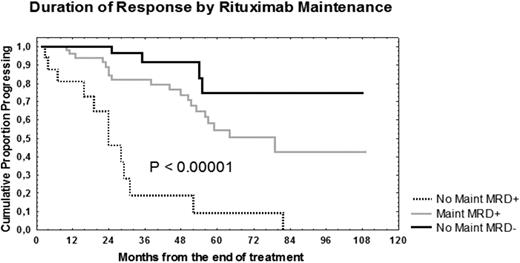Abstract
Abstract 2364
Poster Board II-341
The treatment goal of B-cell chronic lymphocytic leukemia (B-CLL) has already shifted from symptom palliation to the attainment of maximal disease control combining purine analogs with monoclonal antibodies. This immunochemotherapeutic approach resulted both in more complete responses (CR) and longer response duration, often remaining only a minimal residual disease (MRD) detectable by flow cytometry. We treated in first line 120 B-CLL symptomatic patients (pts), median age 62 years, with six monthly courses of intravenous or oral fludarabine at conventional doses and then, after a median time of 31 days, with four weekly doses (375 mg/sqm) of rituximab (rtx). Fourteen pts had a low Rai stage, 103 an intermediate stage and 3 a high stage. We defined as high risk pts having at least two of these markers: unmutated IgVH, CD38>30%, ZAP-70>20%, intermediate unfavorable cytogenetics (trisomy 12 or del11q or del17p). Based on NCI criteria, 92/120 (77%) pts achieved a CR, 24/120 (20%) a partial remission (PR) and 4/120 (3%) no response or progression. Ten pts underwent grade 3 (WHO) infective lung toxicity, 1 patient acute fatal B hepatitis and 2 pts progressed towards Richter's syndrome. Hematologic toxicity included mainly neutropenia (grade 3 and/or 4 in 56 pts) and thrombocytopenia (grade 3 and/or 4 in 8 pts). Fifty-four pts either in CR with B-CLL bone marrow cells >1% (MRD+, n=16 pts) or in CR MRD negative, but with B-CLL peripheral cells going up >1000/microl within 1 year after induction (n=22 pts) or in PR (n=16 pts), underwent consolidation and maintenance therapy with four monthly cycles of rtx at 375 mg/sqm followed by twelve monthly low doses of rtx (150 mg/sqm). The median follow-up duration was 50 months. All treated pts experienced a long progression-free survival from the end of induction treatment (40% at 9 years). On the other hand, global overall survival (OS) was 54% at 10 years. Nevertheless, CLL pts undergoing consolidation and maintenance therapy (n=54) showed a longer response duration vs MRD+ not consolidated pts (n=16; 75% vs 9% at 4 years; P<0.00001, Figure). Noteworthy, persistently MRD negative (>1 year) pts (n=43) showed a very long response duration (79% at 6 years, Figure). Moreover, OS was shorter in MRD+ not consolidated pts (0% vs 79% at 15 years; P=0.0007). Noteworthy, within the high risk subset (n=48), consolidated pts (n=17) showed a longer response duration (56% vs 0% at 2.5 years, P=0.003) vs MRD+ not consolidated pts (n=11). Therefore, rituximab consolidation and maintenance immunotherapy improve response duration in B-CLL, thus potentially increasing OS, also within the high risk subset.
No relevant conflicts of interest to declare.
Author notes
Asterisk with author names denotes non-ASH members.


